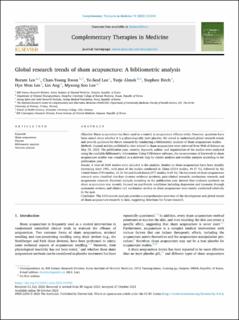| dc.description.abstract | Objective
Sham acupuncture has been used as a control in acupuncture efficacy trials. However, questions have been raised about whether it is a physiologically inert placebo. We aimed to understand global research trends and provide guidance for future research by conducting a bibliometric analysis of sham acupuncture studies.
Methods
Journal articles published to date related to sham acupuncture were retrieved from Web of Science on May 29, 2023. The publication year, country, keyword, author, and organization of the studies were analyzed using the available bibliometric information. Using VOSviewer software, the co-occurrence of keywords in sham acupuncture studies was visualized as a network map by cluster analysis and overlay analysis according to the publication year.
Results
A total of 3428 studies were included in the analysis. Studies on sham acupuncture have been steadily increasing since 1991, with most of the studies conducted in China (1514 studies, 44.17 %), followed by the United States (789 studies, 23.02 %) and South Korea (277 studies, 8.08 %). The keywords of sham acupuncture research were classified into four clusters: evidence synthesis, pain clinical research, mechanism research, and acupressure research. Keyword analysis according to the publication year showed that evidence synthesis on sham acupuncture was recently focused on psychiatric conditions including depression and insomnia through systematic reviews, and clinical and mechanism studies on sham acupuncture were mostly conducted relatively in the past.
Conclusion
This bibliometric analysis provides a comprehensive overview of the development and global trends of sham acupuncture research to date, suggesting directions for future research. | en_US |
